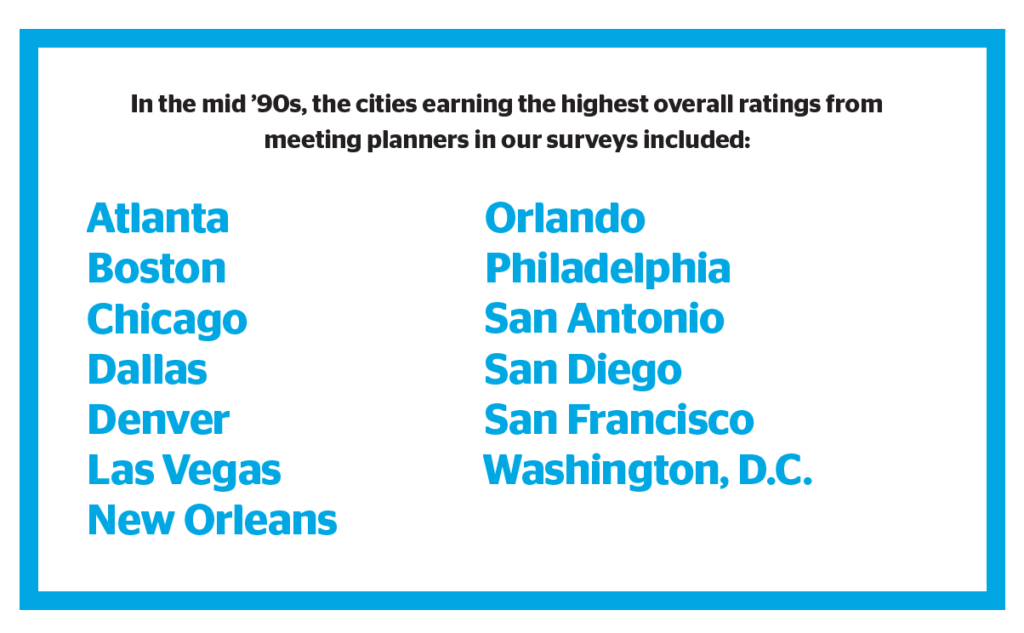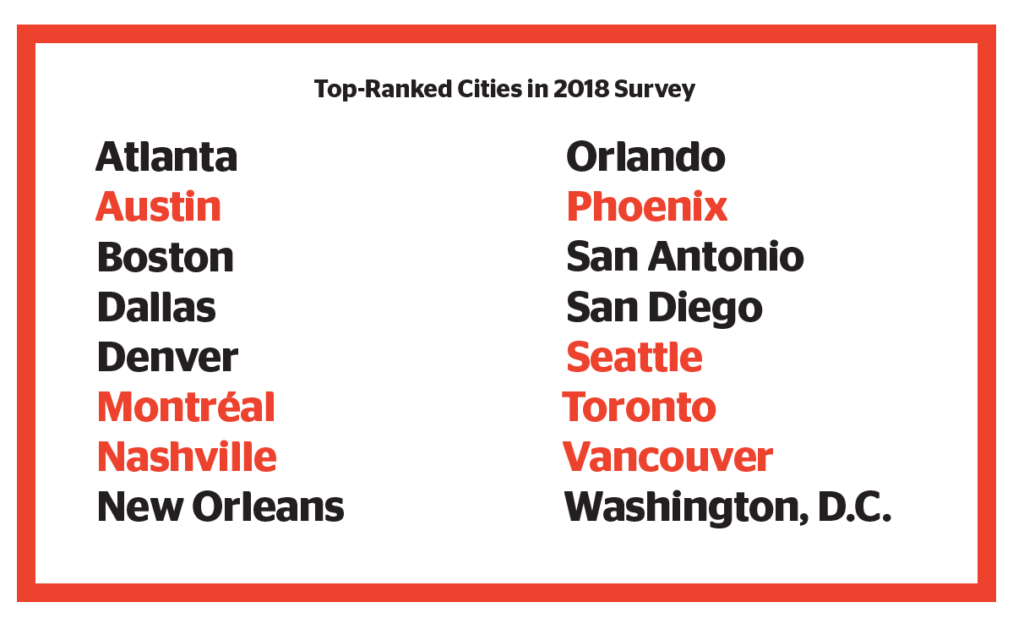
Top Cities Ranked by Event Professionals
Editor’s Note: Watkins Research Group Inc. is a Kansas City–based firm providing primary B2B research on the needs and views of meeting planners and third-party consultants in selecting destinations for their biggest meetings. The Watkins Report for U.S. and Canadian convention bureaus is published biennially, and the 2018 edition was recently released, featuring the responses of nearly 1,000 planners and consultants.
Curt Watkins, principal at Watkins Research, has been conducting this research for CVBs for the last 25 years. Convene asked Watkins to share his perspective on what has changed in what planners are seeking in their host destinations over the past few decades. Here are his thoughts.
We’ve seen tremendous changes in the CVB industry over the past 25 years, more so than in the other industries we follow, which include corporate real estate, legal services, ad agency services, accounting services, insurance, engineering, and pharmacy benefits management.
What’s changed the most? How cities are selected by event organizers to host their meetings, and which cities they perceive as best delivering what they most value, particularly for their larger conventions. Prior to 2001, when we spoke to meeting planners about how they went about choosing cities for major meetings/ conventions (1,000-plus peak night rooms), things looked pretty much like this:
› Almost everyone wanted to travel so it was easy to get people to attend meetings.
› Meetings were not — relative to today’s standards — seen as such a critical source of revenue for associations.
› While some cities offered advantages in accessibility, others in cost, and still others in quality of rooms and facilities, the key differentiator in the 1980s for many meeting planners was the destination’s free-time activities.

Then came the tragedy of Sept. 11, 2001. Suddenly, there were new considerations. Travel budgets tightened dramatically. A new, more difficult travel atmosphere made formerly easy-going attendees — who had been turning out in ever-larger numbers — less willing to queue up at airport security lines. Planners began seeking more from a city than before. At the same time — continuing a trend that started in the 1990s — organizations were increasingly looking at meetings and events as a significant source of revenue. It was more economically important to convince people to attend meetings at the same time that their attendance began to drop off sharply. Twenty-five years ago, a “big meeting” required at least 1,000 peak night rooms. According to our data, 48 percent of the meetings most sought-after by cities today require fewer rooms than that.
Planners were now faced with an increased responsibility to ensure that meetings were more professionally pertinent to their audiences than they had in the previous decades. To offset the combination of financial market weakness and the increased risk and inconvenience of travel, it became important for corporate meetings to focus on both improving business and professional performance and on providing attractive opportunities and settings for the increasingly rare opportunities for face-to- face conversation — pure business augmented with personally satisfying encounters. In fact, it is quite common today to see open time for elective activities scheduled at the very start or very end of meetings, allowing for people to arrive and depart only for the business component of the conference. Since 2001, event organizers have worked more closely than ever with CVBs to plan meetings which appeal to a broader range of interests to boost attendance. Conferences are now required to satisfy a broader variety of attendee needs, and planners must check off more boxes — efficient use of delegate time, convenience, compelling meeting environments, and novel leisure-time activities, among them — to convince people of all different expectations that it’s worth their while to attend.
Over the past 17 years, we’ve seen a steady rise in both the number of factors that are rated important by meeting planners in their evaluation of a city, as well as a rise — almost across the board — in quality ratings of cities evaluated in our biennial study. These are historically considered as the best 40 cities in North America. Our early studies showed a wide range in scoring with clear differences between the top and bottom of the list of cities. A handful rose to the top, most were somewhere in the middle as average, and the few at the bottom made the other cities look even better in comparison.
Today, the differences in ratings among the top half of high-ranking destinations is fractional — there are lots of “probably-can’t-go-wrong” picks. We’ve observed in all the studies we conduct that higher ratings across the board indicate effective communication between providers and buyers. Especially in the past eight years, the evidence among convention cities is compelling. The best CVBs are enjoying the rewards of getting and staying informed with clear and actionable direction, to more confidently lead informed with clear and actionable direction, to more confidently lead their destinations to invest in providing more of what planners say they seek in order to ensure highly successful meetings.
As in all the industries we have followed, some cities seem to have paid closer attention to the changing needs of the market than others. We congratulate the top-ranked cities in our latest survey, below, for listening well and reacting with purpose. Cities in red are new to the list since the mid-’90s group shown above, and while we commend their collaboration with event planners, we recognize, of course, that there are a number of other reasons why they are now popular among planners — including demographic shifts, the rise of the Sun Belt, the growth of tech start-up clusters, etc., over the past 20-something years. (Note also that Canadian destinations were not included in our research before 2000.)

It will be interesting to see what new things become critical to event organizers in choosing host destinations and which nimble cities will make it to the next list in two years. Stay tuned.
For more information, email Curt@WatkinsResearchGroup.com.
Data and insights are from Curt Watkins, Watkins Research Group, Inc., in association with Rick Flaspöhler. Watkins Research’s 200-page reports are graphic-intensive and their insights are designed for marketers to implement more than for statisticians to analyze. Research for the next report will begin in the third quarter of 2019 with results published early in 2020.
Reports — which feature the input of nearly 1,000 meeting planners — provide clear and actionable data about which U.S. and Canadian cities are perceived as doing the best job of hosting big meetings and conventions and why. Each current report compares with previous results. Subscriber CVBs receive a customized report based on the views of their high-value clients and prospects.





